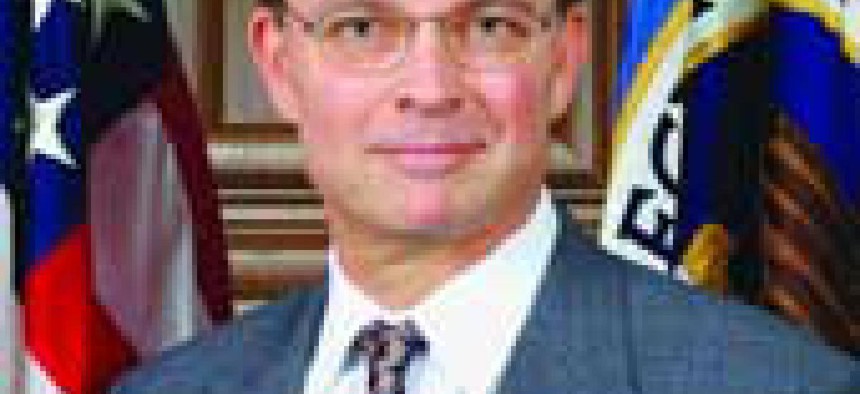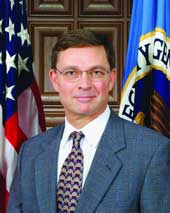Transformation man

As NSA's first CTO, Prescott Winter wants to make the spy agency network-centric.
At the National Security Agency, a federal spy agency whose mission is defined by its use of technology, Prescott Winter is taking on critical new responsibilities.Winter recently became NSA's first chief technology officer and is chief information officer. Those roles consolidate and expand his authority over major projects.NSA Director Lt. Gen. Keith Alexander named Winter to the new posts effective May 15 as part of a reorganization.In an agency whose success depends on acquiring and deploying the latest technologies for collecting and protecting information, Winter's appointment is being viewed as a move to reinvigorate the agency's efforts during a period of challenging transformations.In the new era, NSA must advance national security in cyberspace and conduct surveillance of new digital communications devices worldwide.Security experts say Winter and NSA must overcome skepticism related to the failure of its recent information technology modernization effort, Trailblazer, which was canceled two years ago after disappointing results and hundreds of millions of dollars in cost overruns.Winter is expected to oversee Trailblazer's successor, a mostly classified program known as Turbulence, which has been described as a conglomeration of IT modernization efforts.Winter is a career NSA employee and former leader of its Commercial Solutions Center, which works with companies developing promising technologies in the private sector. He spoke with Washington Technology staff writer Alice Lipowicz about his new responsibilities. In my new position, I am CTO and CIO. There are three to four areas in which to engage technology planning and organizing for it; acquiring and deploying it, working with the senior acquisitions executive; and operating it. NSA is an organization that has an extensive and sophisticated technology framework at the enterprise level.In the CIO office, we also regulate and handle interoperability and Clinger-Cohen (the IT Reform Act of 1996). The CIO position formerly was occupied by the chief of the IT directorate, Kevin Ford. The IT directorate has been consolidated into the technology directorate. Kevin Ford is now the chief of the enterprise technology group. It is a fairly minor organizational change. I started at the NSA right after graduate school at Stanford University. My dissertation was on the history of systems of knowledge in 17th and 19th century Japan. I was looking, over the long term, at how knowledge is changed and structured.The real goal is to make information more available?Information management is fundamentally what we are about. The goal is to move us to a network-centric enterprise, in which any piece of information is discoverable and available to any element of the system, whether it is a person or machine, as long as [the person or machine] is properly accredited, identified and authorized.It is a generic model, and it is where academia and private industry are going. Our challenge is to do it with all our internal protective mechanisms in place. Most of the information [at the NSA] cannot be shared outside of the building. The biggest difference is in the level of focus needed to enhance what we are already doing. It is not a radical departure. My basic task is to bring stronger systems engineering and stronger enterprise processes to work.We have always had robust systems engineering at NSA. We have to begin to integrate across systems. We have to extend the architecture more broadly, building on what we have done before.The mission of the IT directorate is the closest analogue to what we are doing. We will have more authority and can extend the architectures even further. ?We will have a lot of responsibility for information sharing and ensuring interoperability. Our demands and requirements are extending in all directions. The details are classified. Generally most of what we are doing is reorganizing with what we have. It's a reorganizing of businesses processes and governance to achieve a better control of technology and services. We will establish standards and business processes to govern the technology that we are deploying.NSA is famous for our reorganizations. We live in fear of the next reorganization. [Laughs.] There's quite a bit to do. We will be strengthening acquisitions, adding detail and rigor to the enterprise architecture and extending and integrating a capital investment decision process. The first set of integrated architecture roadmaps will be done by July 1. Before we had separate road maps, and they were not linked. Now we have coordinated road maps for our mission, infrastructure, and power and cooling needs. We will have an integration in architecture and engineering processes. In three months, expect major changes. The private sector has been an extraordinarily close and important partner for decades. We'll certainly take advantage of that. Every major bureaucracy reorganizes itself on a regular basis. We will be very successful. It's a big undertaking, a challenging task, which is not fundamentally different from what the private sector is doing. There's a difference between the people running the mission, and those of us doing the technology services on which the mission runs. I cannot talk about classified programs. Yes, I am. Lots of big companies are dealing with these huge data volumes. It's an issue for everybody. All require enormous availability of power.It is under control right now. Impairment of the mission is not happening. As we go forward, we'll do the engineering and plan our investments wisely. We will be working within the budget frameworks that Congress has provided and will be working to optimize, with more bang for the buck. I cannot go into detail. We are being challenged to move faster. Commercial technology is driving and shaping the environment. The volume and velocity of information is increasing. Of course, those are factors here, and for everyone in the IT world.

WT: What can you tell us about your new position?
Winter:
WT: How has your background prepared you for this position?
Winter:
WT: What goals do you hope to accomplish in your new positions?
Winter:
WT: Is this a major change for NSA?
Winter:
WT: Will you be hiring more staff?
Winter:
WT: What is the timeframe for some of the changes you envision?
Winter:
WT: Will there be additional contracting activity?
Winter:
WT: Do you view your new positions as a major challenge?
Winter:
WT: Has the agency been divided into separate missions by this reorganization, as has been reported in the news media?
Winter:
WT: According to news reports, you will have responsibility for deploying technologies in the Turbulence program, which is the successor of the Trailblazer IT modernization program. Is that right?
Winter:
WT: My understanding is that you are tasked with solving the problem of a lack of sufficient electrical power for all your IT systems.
Winter:
WT: Will you be increasing IT investments?
Winter:
WT: What are the forces driving change at the NSA? Is your new position intended to deal with cyberthreats?
Winter:
Staff Writer Alice Lipowicz can be reached at alipowicz@1105govinfo.com.

"We have to begin to integrate across systems. We have to extend the architecture more broadly, building on what we have done before." Prescott Winter
WT: What can you tell us about your new position?
Winter:
WT: How has your background prepared you for this position?
Winter:
WT: What goals do you hope to accomplish in your new positions?
Winter:
WT: Is this a major change for NSA?
Winter:
WT: Will you be hiring more staff?
Winter:
WT: What is the timeframe for some of the changes you envision?
Winter:
WT: Will there be additional contracting activity?
Winter:
WT: Do you view your new positions as a major challenge?
Winter:
WT: Has the agency been divided into separate missions by this reorganization, as has been reported in the news media?
Winter:
WT: According to news reports, you will have responsibility for deploying technologies in the Turbulence program, which is the successor of the Trailblazer IT modernization program. Is that right?
Winter:
WT: My understanding is that you are tasked with solving the problem of a lack of sufficient electrical power for all your IT systems.
Winter:
WT: Will you be increasing IT investments?
Winter:
WT: What are the forces driving change at the NSA? Is your new position intended to deal with cyberthreats?
Winter:
Staff Writer Alice Lipowicz can be reached at alipowicz@1105govinfo.com.
NEXT STORY: A case full of money

